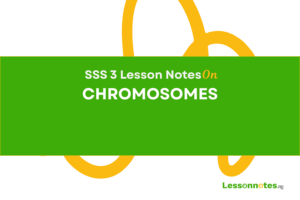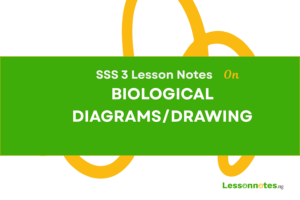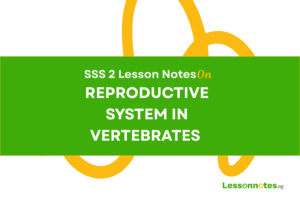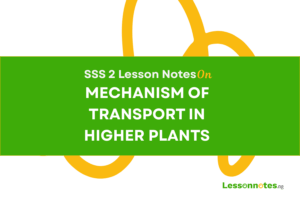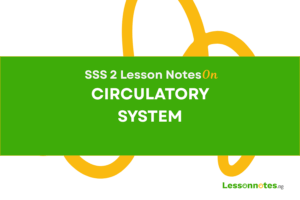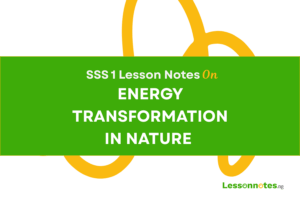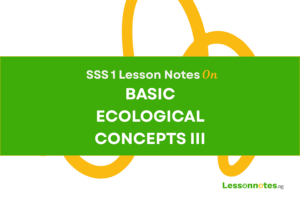Functions In Ecosystem SS1 Biology Lesson Note
Download Lesson NoteTopic: Functions In Ecosystem
FEEDING RELATIONSHIPS
Since all living organisms must obtain energy and nutrients from the environment to remain alive, they are into feeding relationships. This makes an ecosystem a functional unit. All organisms fall into one of the three major groups of biotic community, namely: producers (autotrophs), consumers (heterotrophs) and decomposers.
- The autotrophs provide food for other organisms in the habitat. In terrestrial habitats, they include grasses, trees and shrubs while aquatic autotrophs include phytoplankton, seaweeds etc
- The heterotrophic include: (i) herbivores (called primary consumers) feeding on plants, carnivores (called secondary consumers) feeding on primary consumers and omnivores other animals called (tertiary consumers) feeding on secondary consumers or both.
Terrestrial heterotrophs include cows, dogs, lilionsman etc while water fleas, tadpoles, and larvae of insects and fishes are aquatic heterotrophs
- Decomposers like termites, larvae of houseflies (maggot), bacteria and fungi break down dead organic matter to release simple chemical compounds which can be absorbed and used again.
Of all the three biotic groups, consumers have a better chance of survival than any other in an ecosystem.
TROPHIC LEVELS
In an ecosystem, energy and nutrients are transferred step by step among organisms along a feeding pathway. The feeding pathway in all ecosystems follows a similar pattern which is as
follows:
- It begins with a producer e.g. green plant like grass.
- The producer is eaten by a primary consumer e.g. Zebra, goat.
- The primary consumer is eaten by a secondary consumer e.g. lion.
- Decomposers convert the remains of dead producers and consumers into simple inorganic substances which return to the non–living environment. The difference in the feeding pathways within an ecosystem or between different ecosystems is the termination of the pathway. Some may end at the primary consumer step or may go on to secondary consumer, tertiary consumer etc.
Trophic (feeding) level: each step along a feeding pathway. The order in which the trophic levels are arranged gives the path of energy (food) flow among the functional groups of organisms. The trophic levels are numbered in ascending order, starting from one to indicate the path of energy flow.
Trophic level 1 always consists of producers or autotrophs, and trophic level 2 always consists of primary consumers. Above trophic level 2, consumers could be carnivores, parasitic organisms and scavengers. The final consumers eventually die and are fed upon by decomposers.
FOOD CHAIN FOOD WEB
This is the feeding relationship involving the transfer of energy through food from producers to consumers in a linear form.
Therefore, in a food chain, food energy is transferred from one organism to another in a linear form. Most food chains begin with producers but few of them start with dead plants or animals e.g
Humus > earthworm > domestic fowl > man
Numerous food chains present in an ecosystem produce a food web.
FOOD WEB: – is a complex feeding relationship among organisms in the same environment with two or more interrelated food chains. Food webs therefore contain more organisms than food chains. A single plant could be fed upon by more than one or two organisms. In an ecosystem, a consumer has a better chance of survival because it feeds on different types of plants or animals in a food web.

ENERGY FLOW AND ECOLOGICAL PYRAMID
Pyramids are diagrammatic representations used in ecology. They include the pyramid of numbers, the pyramid of energy and the pyramid of biomass.
- PYRAMID OF NUMBER: this refers to the numbers of individual organisms at each trophic level, decreasing from the first to the last level in a food chain. The pyramid of numbers has the following defects: The individual organisms are given the same status, though they vary greatly in size e.g. grass and trees are grouped as producers and are not drawn to scale.
2. PYRAMID OF ENERGY: This is the amount of energy present in the living organisms at different trophic levels of a food chain, which decreases from the first to the last i. e. from the base of the pyramid to the apex.
3.PYRAMID OF BIOMASS: Biomass refers to the size and number of living organisms. It represents the total wet or dry mass of the organisms at each trophic level. This gives a more accurate picture of the relationship between the organisms at various trophic levels in a food chain than the pyramid of numbers.
ASSIGNMENT
- The ultimate source of energy in nature is A. green plants B. moon C. star D. sun
- The usable form of energy in animals is A. chemical energy B. kinetic energy C. potential energy D. ATP
- Available to photosynthetic plants is ________ of the solar energy. A.1-5% B. 2-5% C. 5-15% D. 1-10%
- The study of the relationship between heat energy and other forms of energy is called_____________. A. thermodynamics B. thermocouple C. thermosetting D. all of the above
- Energy can neither be created nor destroyed but can only be changed from one form to another This refers to the A. first law of thermodynamics B. second law of thermodynamics C. third law of thermodynamics D. none of the above
- State the first and second law of thermodynamics.


